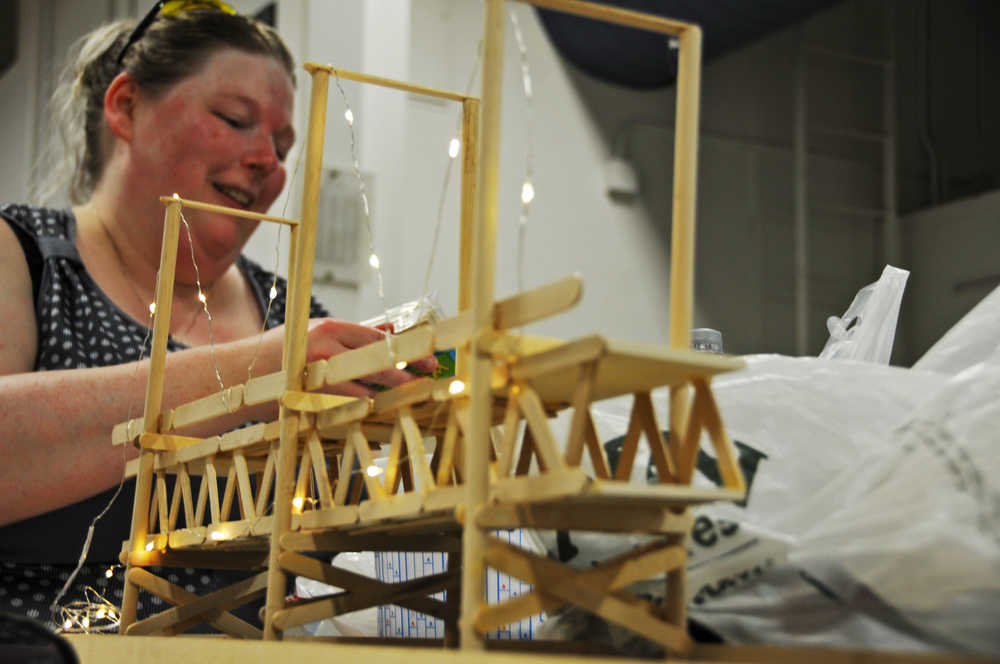When sculptor Cam Choy became an art professor at Kenai Peninsula College in 2013, he had little opportunity to teach his preferred art form. Choy said the art program at the time was focused on painting and drawing, and although there was a small studio for pottery and other ceramics, the college had no space or equipment for larger, heavier work like the metal sculptures in which Choy specializes.
Now, KPC’s new three-dimensional art studio has been open to students in Choy’s sculpture classes for the past two semesters. Soon the public will be able to get a look at the new studio as well with an open-house on Friday evening.
“I really love working here,” Choy said of the studio. “Even if this wasn’t part of the position, I would still love working here. But when I found about it, it was just like icing on the cake.”
Choy said that three dimensional art uses “your basic materials that you find in trades and in industry. It’s those same materials that sculptors use, it’s just that we’re using a different vocabulary.”
Students in Choy’s beginning class start with casting plaster, then move on to woodwork and finally welded-metal sculpture. Along the way, Choy teaches them to use band saws, chop saws, table saws, drill presses, torches, and plasma-cutters.
During a class last week in the new studio, a group of Choy’s beginning sculpture students cut pieces of cardboard into shapes they slotted together to make three-dimensional forms: a wolf, a whale, a plumed serpentlike creature. These are scale models they will reproduce on a larger scale — with planes sliced with a plasma cutter from a 2 square-foot metal sheet. None of the students at the table said they had used welding equipment before.
“It’s new,” said Holly West, a member of the class. “I think that’s what it is for most of us. It’s just not something that we’ve done. … When you take them into a new element, it’s just more challenging because we’ve never done it before. You’re using some machine that could essentially screw up your project, or screw up your finger, or whatever. Going right into it, you’re like ‘oh my god, I’m going to mess up.’ But it gets easier as you go along.”
Choy said that many of his sculpture students are inexperienced with the shop equipment, but unintimidated by it.
“Many of them don’t have a shop background, though some of them do,” he said. “So I treat it as if it’s everybody’s first time in the shop. They take to it pretty quickly. There’s a lot of hands-on demonstrations, a lot of hands-on helping. … After a couple of times it’s second nature.”
Metal, according to West, is a less forgiving medium than clay or wood.
“Measure twice, cut once,” said West, repeating some sound advice. “Same thing with the plasma cutter. Your arms tweaks just the right way, and you mess up your entire project. That’s the most challenging thing for me — knowing that it could happen.”
In addition to welding, future students will learn to work with metal in a different way. When the studio is complete, it will have a foundry with a gas-fired furnace for metal casting.
When the foundry is working, students will be able to cast bronze or aluminum sculptures from models using molds made from sand. After being mixed with a resin, the sand is packed around the object to be cast. The resin causes the sand to harden to a bricklike form into which liquid metal can be poured. Choy said he expects the foundry to be working in time for class registration next fall.
When asked if there are any artistic effects that can achieved in metal sculpture that aren’t possible in ceramics, Choy mentioned scale. He’s presently starting a sculpture for Central Peninsula Hospital’s new River Pavilion — a 12-foot long, 9-foot tall metal salmon with a spring-articulated tail. He said he didn’t know of any students planning similarly massive projects, though if any large ideas do arise, they now have a place to become real.
Reach Ben Boettger at ben.boettger@peninsulaclarion.com.

